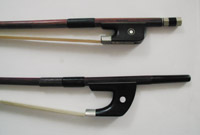
François Xavier Tourte was a French bow maker who made a number of significant contributions to the development of the bow of stringed instruments, and is considered to be the most important figure in the development of the modern bow. Because of this, he has often been called the Stradivari of the bow.
In music, a bow is a tensioned stick which has hair coated in rosin affixed to it. It is moved across some part of a musical instrument to cause vibration, which the instrument emits as sound. The vast majority of bows are used with string instruments, such as the violin, viola, cello, and bass, although some bows are used with musical saws and other bowed idiophones.

A Baroque violin is a violin set up in the manner of the baroque period of music. The term includes original instruments which have survived unmodified since the Baroque period, as well as later instruments adjusted to the baroque setup, and modern replicas. Baroque violins have become relatively common in recent decades thanks to historically informed performance, with violinists returning to older models of instrument to achieve an authentic sound.

Dominique Peccatte was a French luthier and above all a renowned bow maker. He was apprenticed in Mirecourt and later worked with Jean-Baptiste Vuillaume.
François Nicolas Voirin (1833–1885) was a French archetier (bowmaker), known in his time as the "Modern Tourte."
Nicolas Maline was a luthier and an archetier/bow maker.
Nikolai Ferdinandovich Kittel was a Russian violin and bow maker who is often still mistakenly considered as of German origin, and was known as the "Russian Tourte". According to the latest findings, his full name was Nikolai Ferdinandovich Kittel and that he was of Austrian origin as stated in his marriage certificate. Kittel always signed letters and invoices with the name Nikolai Kittel. In all German and French documents, he was named Nikolai, and not Nikolaus.
Charles Peccatte was a French Archetier. He was born in Mirecourt, the son of François Peccatte and the nephew of Dominique Peccatte. He was trained by August Lenoble with whom he later had a partnership which lasted until 1881. The early work includes very individual bows which can be described as of the Peccatte school but many of which have heads modelled somewhat after the early type of bow by François Tourte.
Pierre Simon, was a French archetier or musical bowmaker.
Joseph Fonclause (1799–1862) was a French archetier/bow maker. Went to Paris to work for Lupot, Tourte and Vuillaume. From 1840 he worked alone. Most of his bows are stamped. Early in his career, he followed the Pajeot style. Nevertheless, later followed a very different direction on the basis of what was soon to happen in Paris.
Joseph Arthur Vigneron was an important French Archetier / Bowmaker.
Victor François Fétique was a prominent French archetier (bowmaker) from a family of bowmakers.
Jean Pierre Marie Persoit [Persois] - was a great and intriguing French bowmaker or Archetier.
Étienne Pajeot [Pageot], was an illustrious French archetier and bowmaker.
Jean Adam (1823–1869) was a Master French bow maker known as "Grand Adam" . His bows are highly sought after.
Jean Dominique Adam was an illustrious French Archetier / Bowmaker.
A bow maker is a person who builds, repairs, and restores ancient or modern bows for bowed string instruments. These include violins, violas, cellos, double basses, viola d'amore, viola da gamba, etc.
Caressa & Français was a distinguished firm in Paris that specialized in fine musical instruments and bows.
Jacob Eury was a French luthier and bow maker. He was apprenticed in Mirecourt with his father as a violin maker, and later became an archetier / bow maker. According to the Paris census, he was noted having been in Paris as of 1792, where he certainly had some association with François Tourte. Throughout his life he moved many times and seems to have struggled financially. His work however never seems lacking. Top experts, agree that Eury's work is often compared to that of Tourte.
A Galliane is a bow frog for stringed instrument bows that sets the hair ribbon at an angle. This kind of frog was first described in Scientific American in October 2012. It was invented by bow maker Benoit Rolland for violin, viola, cello, and double bass bows.





